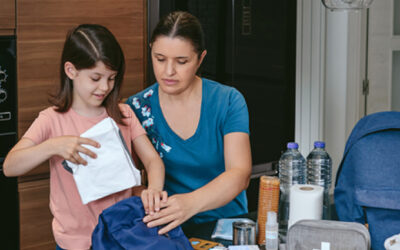Being there with women as they receive a breast cancer diagnosis is sacred work that Evelyn Goodrow, RN, BSN, OCN, feels called to do.
At Our Lady of Lourdes Breast Center, Goodrow’s job is primarily education, helping patients make sense of and navigate their cancer treatment, connecting them to care across the continuum. She serves as a safety net for patients as they begin their breast cancer journeys.
Helping Patients Navigate the Diagnosis
In today’s healthcare world, navigating electronic systems can be overwhelming especially when faced with a cancer diagnosis, head swimming with questions and anxiety.
“A lot of what I do is coordination of care: arranging referrals, informing patients about what is needed for the appointment and what will occur,” Goodrow says. “I work out any obstacles with the referring physician’s office or the hospital.”
She works as a point of connection and problem solver. Having someone to call is very comforting for patients, and many hold onto Goodrow’s phone number, calling years later even after treatment is complete when new questions arise.
Knowledge is Power
“Women can only deal with a breast cancer diagnosis by understanding what they’re dealing with,” Goodrow says.
She provides that information and knowledge while listening carefully to understand any needs that may remain unspoken. That may look like encouraging a patient to ask for help or nudging a family member or partner to meet a specific need.
“It’s important to listen to understand the questions they have,” she says. “They may be asking one thing but there’s a big underlying thing they may be afraid to ask or think is too silly. Most questions are multilayered so you really have to listen to understand what they’re asking to answer them appropriately and completely.”
Making Time for Listening
“Listening occurs on a daily basis,” Goodrow says. “Listening and allowing patients to absorb the information about their diagnosis, to let go and be able to cry and know that’s OK” is an important part of her work. “We’re not superwomen, and you have to be able to experience those emotions in order to work through them.”
Goodrow works with patients as they receive their breast cancer diagnosis, and Jeannine LaFrance, NP, oncology nurse navigator at Our Lady of Lourdes JD Moncus Cancer Center, picks up the navigation role for patients as they need surgery or other care at the hospital.
“My interactions with a patient start at the time when we’re planning and scheduling a biopsy, getting health information, answering questions, going through the biopsy itself and working with the radiologist to get results,” she says. “It’s a short time frame, so listening is really important.”
Busting Myths About Breast Cancer and Screening
One of the misconceptions Goodrow wishes would go away is the idea that mammograms are excruciatingly painful, a myth that scares women away from this lifesaving screening process. The earlier you find cancer the better your outcome can be. Survival rates continue to improve with earlier detection and new breast cancer treatments tailored to each patient.
Technology is always advancing, and current mammography equipment is designed to make screenings less painful. Goodrow also notes that the amount of compression is unique to each patient and mammography technologists will work with patients to complete a screening to have the most comfort possible while getting high-quality images.
Another common misunderstanding for patients is the difference between an annual screening mammogram, which are for those having no problems and typically covered by insurance as part of wellness, and a diagnostic mammogram, a more involved imaging scan that is considered a diagnostic procedure and may be subject to a deductible or co-insurance
“Women are more empowered than ever to make their own healthcare decisions and have a choice of where to get their mammograms,” Goodrow says. Consistency, receiving regular mammograms at the same facility, is so important because radiologists will have easy access to all past scans to review for subtle changes.
While coordinating care with technology can be tricky, doing your own research can be equally challenging. Goodrow recommends avoiding misinformation by only relying on information from evidence-based, reputable and regularly updated sites. Her recommendations include the American Cancer Society, Susan G. Komen, Breastcancer.org and the National Cancer Institute.
Care Close to Home
“We have excellent breast cancer care in our community,” Goodrow says. “A lot is available to our patients where they don’t have to travel outside of the state. They can receive wonderful care close to home with family and their support system.”
Having a local care team here to help is also so valuable.
“We are here to help patients, and I mean that sincerely,” Goodrow says. “Every question they have is important and there are people here to help. Utilize those people who are available to help you get through this complicated process.”




